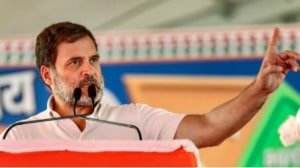Speak Easy: Baba Lives
A new book on Gumnami Baba offers a refreshing take on the man many believed to have been Subhas Chandra Bose.
 Adheer Som’s Gumnami Baba: A Case History. (Source: http://www.amazon.in)
Adheer Som’s Gumnami Baba: A Case History. (Source: http://www.amazon.in)
One of the liveliest reading lists out there is not on Goodreads or from a book club. It is in a chapter titled ‘The Things He Left Behind’, in Adheer Som’s Gumnami Baba: A Case History (an unusual title for the law publisher Eastern Book Company to publish). In 1986, the Allahabad High Court ordered an inventory of the contents of the two rooms in Faizabad which Gumnami Baba, whom many believe to have been Subhas Chandra Bose, spent the last years of his life. The 900 books found in them reflect the wide interests of a Bengali gentleman into fiction, history, philosophy, yoga, fortune-telling and politics.
A collection of newspaper clippings ventures even wider, into weaponry (mention in the Lucknow Pioneer of a 9 mm pistol from the Ishapore Gun Factory and a .38 Smith & Wesson), Netaji lore and a story headlined ‘Goa Holds the Key to Pandav History’, derided by the sage in the margin: “Hahaha! Hoy hoy!” Nevertheless, Gumnami Baba is ripe for the plucking by the right, for the marginalia in books and clippings frequently put down Jawaharlal Nehru. Kuldip Nayar’s autobiography Between the Lines and India: The Critical Years apparently bear notings like, “Stupid Nehru!”
Especially intriguing are personal observations, like the one accompanying a passage in Himalayan Blunder, in which Brig JP Dalvi wrote, “This book was born in a POW camp in Tibet on a cold, bleak night.” The terse annotation in Gumnami Baba’s hand reads, “Very true; me witness.”
The library shows a questing mind: The Constitution of Bangladesh, Neville Maxwell’s India’s China War, Frank Moraes’ The Revolt in Tibet, Will Durant’s The Story of Civilisation and the Arthashastra share the shelves with Charles Berlitz’s The Bermuda Triangle (a world bestseller in the Seventies), Dr Ganpati Singh Verma’s Dhatura Gyan-Vigyan, Celebrated Crimes, Leslie O Korth’s Healing Magnetism (another Seventies obsession) and Gopinath Kaviraj’s Tantrik Sadhana aur Siddhanta.
In literature, Mrichchhakatikam, Geet Govind and the Panchatantra shared mindspace with Henry Miller’s Tropic of Cancer, the Iliad, Tarashankar Bandopadhyay’s The Judge, the collected works of Michael Madhusudan Dutt, Nietzsche’s Thus Spake Zarathustra and Carry On, Jeeves. Works on Indian mystical traditions were also prominent — Ramakrishna Kathamrita, Swami Vivekananda’s Raja Yoga — apart from numerous works referencing Subhas Chandra Bose, such as Nanda Mukherji’s Vivekananda’s Influence on Subhas and Oi Mahamanab Ashe (There Comes the Great Man), a collection of writings by Gumnami Baba’s Bengali disciples.
This may seem like an extraordinary collection in our normative times, and context matters, too — Gumnami Baba, or Bhagwanji, or Pardewale Baba, the names he used earlier, lived in Ram Bhavan in Faizabad, in the home of Guru Dutt Singh. Singh was the sympathetic magistrate who had something to do with the ‘miraculous’ appearance of Ram Lalla’s idol in the Babri Masjid premises, which set Hindutva politics rolling. But this collection, with its vast range from the Arthashastra to the Bermuda Triangle, would not have been out of place in the library of a reasonably well-off and well-educated family in Kolkata in the Seventies. Some colourful usual suspects are absent, of course — Mickey Spillane, Zane Grey, Ellery Queen, Arthur Hailey, AJ Cronin, Khushwant Singh and Bhagwan S Gidwani.
Adheer Som’s Gumnami Baba is part of a Netaji season which appears to be in progress. He makes no claim to rigour, which makes his work quite refreshing. And with the focus on Gumnami Baba — dead and cremated — rather than Bose, Som transcends the eternal question of whether Netaji is/was the Schrodinger’s Cat of modern history, neither dead nor alive, but both dead and alive.
Som’s book is forewarded by Jayanti Bose Rakshit, a grand-niece of Netaji (Som himself is the grandson of Netaji’s elder brother, the nationalist Sarat Chandra Bose). Ashis Ray’s Laid to Rest: The Controversy Over Subhas Chandra Bose’s Death (Roli Books), is foreworded by Anita Pfaff, Bose’s daughter by Emilie Schenkl. Pfaff believes her father died in Taiwan, but the fog of war makes it impossible to be certain. While Som’s book is notable for the intriguing listing of Gumnami Baba’s belongings, interviews with some of the dramatis personae and details which may be known to the Bengali reader but unavailable in English, Ray’s book is notable for collecting practically all the available records and correspondence on the crash in Taiwan. They are also available on Bosefiles.info, and include a hand-drawn map of the airport, showing the location where Bose was found, badly burned.
Doordarshan Kolkata is showing an interesting documentary on Bose (only in Bengali, it seems) centred on interviews with his niece, the educationist Krishna Bose and her son, the historian Sugata Bose (both have been Trinamool Congress MPs). She reveals that Bose’s disappearance was covered up for days because he was declared bedridden and his meals were sent to his room, where no one was allowed. There should now be keen interest in who was eating those meals in the room, since the subterfuge would have been discovered if the plates returned full. The high point is the Wanderer sedan in which Netaji was spirited away from house arrest into Bihar by his nephew Sisir Kumar Bose in 1941, and which was made roadworthy again last year. Pranab Mukherjee, who took
an inaugural ride in it, declined to sit in the rear seat, in which the man who may or may not have become Gumnami Baba once began the longest journey of
his life.
Pratik Kanjilal lectures a surprisingly tolerant public on far too many issues.
- 01
- 02
- 03
- 04
- 05































